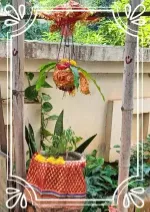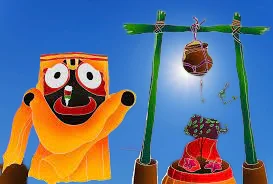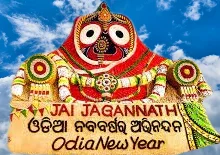Pana Sankranti or Maha Vishuba Sankranti also known as Mesha Sankranti is widely celebrated across Odisha as the traditional ODIA NEW YEAR with religious fervour and gaiety. The Odia new year is usually celebrated on 14th or 15th of April, every year. It is similar to the other new year festivals of India like the Baisakhi, Puthandu, Pohela Boishakh etc. In 2023, this year it will be celebrated on 14th April.
PANA SANKRANTI
This festivals marks the beginning of summer. The new year festivals all over India are a visual sensation. Be it Baisakhi or Vishu or Pohela Boishkah or Puthandu, the enthusiasm and fervour of the people throughout the country remains same. These festivals are actually harvest festivals which is celebrated with great joy, welcoming a new year and a new season.

Coming back to Pana Sankranti, it is also a very unique festival of India. The observances and celebrations differ by a few rituals and customs. So, let us take a look at the observances and significance of Pana Sankranti.
On the day of the Pana Sankranti, an earthen pot ( An important ritual observed during Pana Sankranti is Basundhara theki – A water filled earthen pot with a small hole at the end is placed at the top of the holy basil plant, so that water keeps dripping on the plant ) is filled with a sweet drink which is known as Pana. Then the pot is hung over a Basil (Tulsi) tree. A hole is made at the bottom of the pot to allow the sweet water to fall drop by drop. This represents the rainy season.

A mixture of horse gram flour, banana and curd is offered to the Basil plant. After that it is consumed by the members of the family. Special offerings are also made to the Gods and Goddesses to begin the new year on a good note. In some places of Odisha special fairs like the Charaka Padva and dance known as Danda Nach is also held.
CELEBRATION
People from all over the state eat festive Chhatua and drink Bela Pana to mark the occasion. The Bela Pana is prepared with Bael, chhena, grated coconut and fruits, spices like ginger and black pepper and sugar or jaggery. Pana Sankranti also marks the birthday of Mahaveer Hanuman, and is celebrated as the New Year of the Odia community, and the first day of the Solar calendar. This festival of harvest in Odisha is celebrated by drinking the traditional Odia drink, Pana.
According to the famous folklores in the state, drinking Pana is symbolic and represents the importance of water in sustaining life on earth. People celebrate this new beginning by visiting shrines. Many social groups arrange large amounts of Pana for people travelling from one place to another and establish Jala Chatra- Water Points across towns and villages to serve the society during the scorching heat of summers. Jal Dana- Water offering is considered a very auspicious deed, and you can see many social groups voluntarily coming forward to do it.

Pana is traditionally made by mixing a variety of ingredients like yoghurt, fruits (apple, banana, grapes, orange, pomegranate, mango and most importantly stone apple that is locally called Bela), sugar, jaggery, dry fruits (cashews, raisins, almond), full-fat milk, grated coconut, crumbled khoya, horse gram flour (chhatua), crushed black pepper, cherries for garnishing. Nowadays, people also add ice cubes for chilling the drink or ice cream for added flavours. When all of these ingredients are mixed, a thick yummy, nutritious beverage is prepared.
When prepared in large quantities for distribution, people often opt for simple and easy to make recipes like using only yoghurt and some sweet or savoury flavouring agents. These are made with the intention to keep people safe from sun-stroke.
Odia families enjoy Pana throughout the summer and also relish it during different festivals like Shivratri, Holi, Rath Yatra and many more. Simple Pana recipes like taking out the juice of stone apple (Bela) and serving it after adding sugar or black pepper is a primary go-to drink for summer for rehydration.
Temples and community centres also serve Pana after offering it to the tulsi plant. You may also notice people arranging small clay pots near tulsi plants at their homes and temples with a small hole in them that drips water and Pana as an offering to the Goddess. This Pana is majorly made of the flour of horse gram, curd, and banana.
Pana Sankranti also marks the end of the 13-day Danda and Jhamu Yatra observed in Southern Odisha.
Pana Sankranti is related to new year festivals in South and Southeast Asian solar New Year as observed by Hindus and Buddhists elsewhere such as Vaisakhi (north and central India, Nepal), Bohag Bihu (Assam), Pohela Boishakh (Bengal), Puthandu (Tamil Nadu) etc.
The significance of the day is that the new Odia calendar or Panjika ( The New Year in the Odia calendar is known as Maha Bishuba Sankranti or Pana Sankranti. It occurs on the first day of the traditional solar month of Meṣa (Georgian: Aries), hence equivalent lunar month Baisakha (odia: ବୈଶାଖ) )is also introduced which is an almanac of Hindu festivals and contains the dates of festivals, auspicious days and timings, timings of sunrise and sunset along with horoscopes for the year.
Places to visit in PANA SANKRANTI

Across Orissa, this festival is celebrated with great reverence and enthusiasm. People visit pilgrimage places and temples, take a bath in rivers and make special offerings to their deities. Many places have fairs or melas, where people get to enjoy themselves with families and see dance and singing performances. These fairs have stalls of food, traditional crafts, and other products.
On the streets, too many local artists perform street dances or do acrobatic performances. The day’s main attraction is a social celebration where people walk or sprint on burning coal. It is known as the coal walk, and many volunteers participate. To cheer them, numerous people gather. Many places and temples are known for their Maha Vishuba Sankranti celebrations. The following places are worth visiting during Maha Vishuba Sankranti:
1) Brahmapur- The Taratarini Temple is near Brahmapur and is popular for its Maha Vishuba Sankranti celebrations and its Shakti Pitha shrine. Numerous devout visit it to seek blessings from the goddess. A fair is organized near the temple, which the devotees enjoy after worship.
2) Cuttack- People visit temples, offer prayers, and feast with their families. There is a Jhaamu Yatra in the Devi temple, and many people from across Orissa come to see the procession. There is much poetry, and other literary functions also organized on this day.
3) Chhatrapada, Bhadrak- The Maa Patana Mangala Temple has an annual Patau Yatra festival. Several devotees gather to seek blessings from the Devi or Goddess and witness this festival.
4) Chandanewar, Baleswar- Numerous devotees visit the Shiva temple here. There is an annual fair held on the premises. Many pilgrims from outside Orissa too visit to seek blessings during this period.
5) Sarala- The Sarala Temple is known for the fire walk done by the priests of the temple. It is called the Jhaanu yatra or the fire-walking festival.
1 thought on “PANA SANKRANTI, Maha Vishuba Sankranti, Odia NEW Year, Facts, Significance, Celebrations”